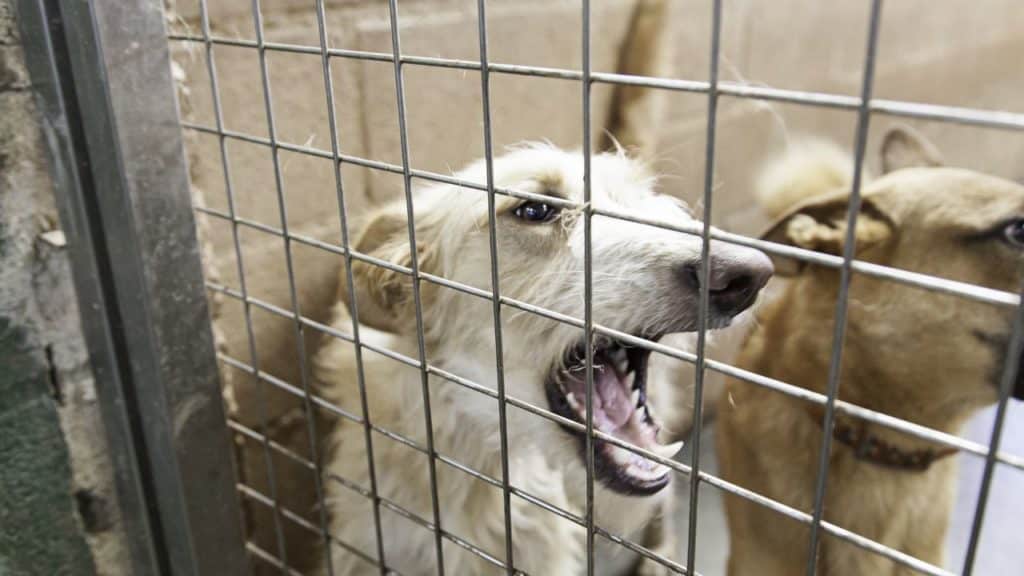
We all know how much our furry friends love to get out of their kennel. Whether at the vet, dog park, or even your home, did you know that they can do some serious damage if given a chance? With this article, I will show you 3 easy ways to make your kennel escape-proof for when you are not around!
Before you begin, you need to be aware of what type of kennel your dog has:
- Wire/Metal Kennel
- Plastic/Crate Kennel
Way 1 – Install a wire door if possible at the bottom of the dog’s kennel. A wire door will be easier for your pet to escape through rather than them chewing or breaking their way out.
Way 2 – Attach a high-value toy or treat to the inside of their kennel. This will ensure that your dog will go into their kennel whenever you put them in and stay there as they try and figure out how to get it.
Way 3 – Lastly, if you want to ensure that your pet is extra secure, I recommend attaching two more toys and/or treats to the outside of their kennel. This ensures that they will be sitting in there without distractions until you come back for them!
The most important thing to remember when attempting these steps is patience. Do not expect your dog to get it right away, it may take a few days! But, on the other hand, these methods will take some time, so don’t give up!
Plastic kennels are usually equipped with a locking system, and if one locking system is not working, you can buy another one to attach. This will make both systems into one to ensure that the kennel door is always locked.
It is also possible to fix another door with little DIY engineering.
Reinforce weak spots To Make Your Dog Kennel Escape Proof
If the kennel door is made of plastic, you can use metal screws to reinforce it. You should use thick and tough wire to fix all potential weak spots on the doors. You will see that some dogs are really clever when it comes to escape, so you need to be proactive.
Add padlocks
There are certain cases when you cannot make the kennel escape-proof. For example, when you travel, with your dog, they must be transported in a special vehicle due to their size or weight.
This is not always an option, so if this happens, then it might be better to attach a padlock to the escape-proof kennel. This way, your dog will be safe, and you can relax for a moment.
Be aware of your surroundings.
Most people think that when they leave their pet in a room or on their own, they are safe, but that is not always true.
Other animals, strangers, kids, etc., can harm your canine without you being aware. For this reason, it is always best to see what your dog does while you are away from them.
You can do this by fixing hidden cameras or placing a motion detector. This way, you will get alerts on your smartphone when something happens that requires your attention.
You should also have a special system for letting the dog know that you are home. This can be done with an alarm system or a bell that your dog will recognize.
Use Of Tarp to Make a Dog Kennel Escape Proof
To begin with, you should hang a tarp from one corner of your dog’s kennel.
Fold the tarp in half and lay it over your outdoor dog cage. Next, fold each side of the tarp back over itself. The tarp should now be completely circular in shape to fit your dog’s kennel.
Third, make a couple of holes in the opposing corner of the one secured to the fence. For this job, you may use an eyelet punch tool. One of the grommets should be attached to the tarp. This can be done by inserting the grommet pieces into your eyelet punch.
To finish, use the tool to push the grommet into place. You may then secure the corner of the tarp to a fence using this method. To properly secure the second pair of corners, repeat these steps.
The eyelet should be utilized to punch a few more holes in the tarp in your fourth stage. This will be required to attach extra grommets along the previously folded sides of your tarp, as many as you want. Please make sure they’re at least one to two feet apart.
Finally, untie your tarp and turn it over. The folded edges should now be beneath the surface of the rest of the tarp after you’ve done so. This is the easiest method to eliminate any top folds that might accumulate rainwater and create a health hazard.
The final step should be to connect your tarp to the fence firmly. To do this, use fencing ties. The aim will be to loop a fencing tie through every grommet you’ve created in the tarp.
Twist these ties and then loop them around the top bar of your fence before securing them with a wire clip
This will result in the tarp being fully stretched across the top of the kennel. It will also be firmly fastened to the wall. This is a setup that prevents your dog from gaining a foothold on the fence and using it to climb or jump over.
How To Chew Proof Your Outdoor Dog Kenne ll
It is sad that many dogs chew their dog kennel, and it will require much work to make sure you have done everything possible to ensure your pet cannot escape.
It is important to know if your doggie kennel has been chewed before you get them because the damage can be very costly and time-consuming.
A friend with a pet door had to pay $ 400 to replace the wire in his dog kennel.
Checking For Chew Damage On Outdoor Dog Kennels
1) Check out any weak points on your outdoor doggy kennel that your dog could escape from. For example, if there is any possibility of chewing, you will need to take care of this before bringing your pooch home.
2) Check to see if your doggie kennel has any tears, chewed wires, or openings that would allow a dog to escape. If so, you will need to either repair it yourself with fencing materials from the hardware store or hire out the repairs to someone who knows what they are doing.
3) Monitor your dog when playing outside to see if it spends any time near the doggie kennel. You can also use a wireless camera system like those in home security systems or baby monitors to keep an eye on your pooch while you are at work or away from home for long periods.
4) Make sure your dog has plenty of toys, water, and shade when they are outside in their doggy kennel. This will help with their happiness and well-being so that they won’t think about chewing on the kennel to get out and explore.
5) If you have a small pooch, purchase an outdoor doggy kennel for a smaller pet. This will discourage your dog from chewing on the kennel and make sure they are safe and secure while playing outside.
6) When you get home from work, take your dog for a walk or let them play in the yard to help them release any pent-up energy that may be the cause of them chewing on their kennel. You can also keep your pooch inside when you are away to ensure they don’t get into mischief while you are not there to watch them.
7) If your doggie kennel has been chewed and repaired in the past, take a look at the repairs and see if they are still holding up. If they fall apart when you tug on them, you will need to replace that section of fencing because it is not safe for your dog.
8) Purchase a chew-proof outdoor doggy kennel, so you don’t have to worry about your pooch chewing through the netting. Check for a coating that is made to be chew-proof, and make sure it can stand the test of time outdoors in all kinds of weather conditions.
Also, check out the locking mechanism because you want something to keep your dog secure while still being easy enough for you to use.
Why Does My Dog Keep Breaking Out Of Her Cage?
Many dogs have a habit of chewing their dog kennel when it’s time for them to settle down and go to sleep for the night. After all, your pet is much more comfortable inside their own home than sleeping outside in a doghouse or on the ground.
Find the reason behind the escape before you go out and purchase a new dog cage, and you must find the root cause of your pet’s behavior.
As mentioned earlier, she might be trying to escape because she doesn’t like sleeping in an uncomfortable space.
Can A Dog Hurt Themselves In A Crate?
Your dog may hurt themselves if they’re trying to escape from their crate by chewing and clawing at the bars. The good news is that this can easily be prevented as long as you follow some simple tips on making your dog kennel escape-proof.
The first thing you should think about when looking to prevent your pet from escaping is to purchase a small dog kennel that isn’t too large for the inside of your home.
If you have an extra-large crate in your bedroom, your pet will have more than enough room to stand up and turn around.
Your dog will be able to chew the bars of a large kennel without any trouble, so you should always purchase an enclosure that’s small enough to prevent your dog from getting her limbs stuck in between the bars.
If you’re looking for some extra security, make sure that all of the screws are tightly fastened into place before using it.
Always place a dog bed inside the kennel before your pet goes to sleep for the night or when you need to leave the house. Your pet must have a soft area to rest on when she’s locked up, so purchase one today.
Lastly, Crate Train Your Dog to
Get Them Used To Be Inside
Crate training your dog is the easiest way to keep your pet from trying to escape and makes a crate much more pleasant for her to be locked in.
She’ll feel less anxious because she’s been taught how to use the kennel, and you’ll be able to leave your house without worrying about her destroying anything.
So now that we have discussed some ways on how to make your dog kennel escape-proof, I hope that you are feeling more confident in purchasing a new enclosure for your pet.
Remember to take it slow if she’s never been in a kennel before and take her to the store with you when you are shopping so that she can get used to all of the different available styles.
